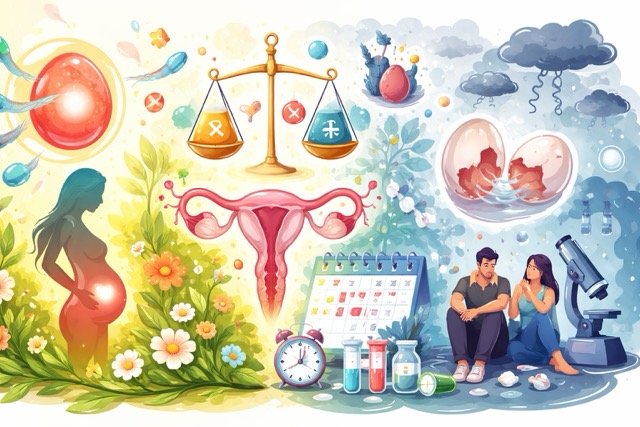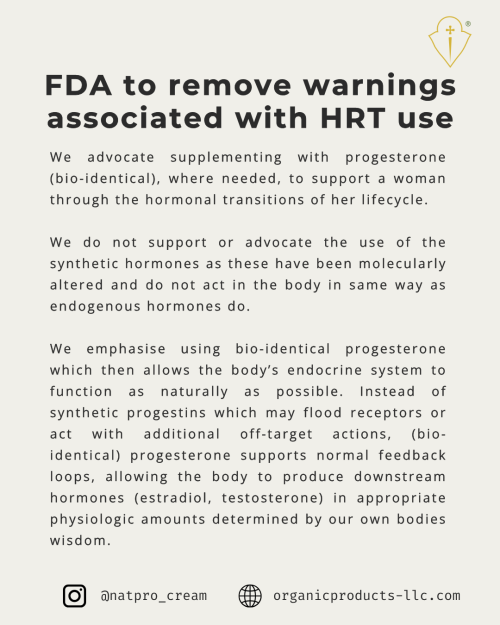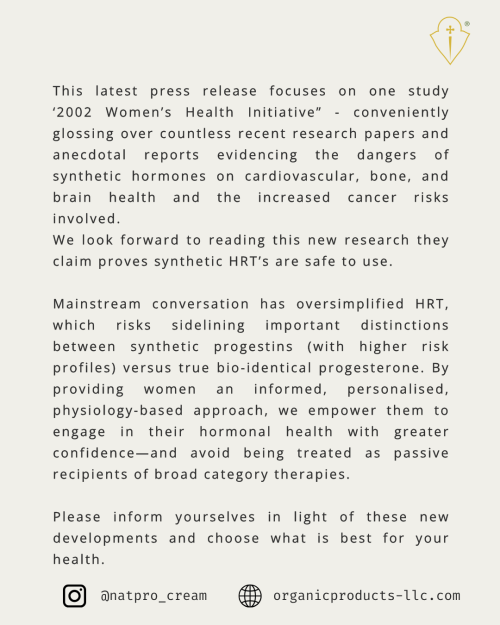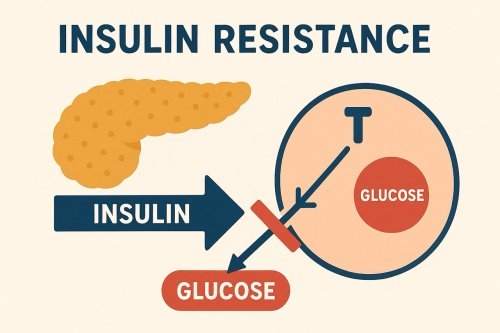Can progesterone help recovery from Polycystic Ovarian Syndrome (PCOS)?
PCOS is a condition that is rising alarmingly all over the world.
It is the most prevalent reproductive problem in young girls and women, affecting up to 10% in the 15 to 50 age group. Although reaching almost 25% if women with mild cystic ovaries and ovaries damaged by the contraceptive pill are included.
PCOS is generally considered a syndrome rather than a disease, because it manifests through a group of signs and symptoms that can occur in any combination, rather than having one known cause.
Other names for Polycystic Ovary Syndrome are Stein-Leventhal Syndrome, hyperandrogenic chronic anovulation, functional ovarian hyperandrogenism, and Polycystic Ovary Disease.
Symptoms vary and include some or all of the following...
- oligomenorrhoea (absent or infrequent periods) or amenorrhea (no menstrual period). The normal cycle length is between 21 to 35 days. But in women with PCO the cycle length can vary from every 6 weeks, to only 1 to 8 periods a year, to none at all. Other symptoms include include lengthy bleeding episodes, scant or heavy periods, or frequent spotting. Ovulation would be infrequent or not at all, leading to a drop in progesterone levels
- enlarged ovaries (usually 1.5 to 3 times larger than normal) with a few to many follicles arrested in growth, commonly called...
- cysts (fluid-filled sacs), giving the classic "string of pearls" appearance to ovaries with many cysts. PCOS is difficult to diagnose without the presence of some cysts or ovarian enlargement. Often the underlying cause is inflammation, which would not be picked by the radiographer. Cystic ovaries can lead to...
- chronic pelvic pain - although the exact cause of this pain isn't known, inflammation is the most likely cause. It is considered chronic when it has been noted for greater than six months. But follicles arrested in growth cannot ovulate, which leads to...
- anovulation (lack of ovulation), which is relatively common as the follicles mature only occasionally, this leads to...
- low progesterone levels, as it's only after ovulation that the follicle, now called the corpus luteum, produces progesterone. But low progesterone levels lead to...
- high levels of luteinising hormone (LH) as the pituitary is trying to stimulate ovulation. High LH suppresses follicle stimulating hormone (FSH) so this leads to arrested follicle growth in the next cycle. But LH also stimulates the thecal cells in the ovary to produce androgens which leads to...
- high androgens (hyperandrogenism), particularly high testosterone, androstenedione, and dehydroepiandrosterone sulfate (DHEAS), leading to excess facial and body hair, male pattern baldness, deepening of the voice, weight problems including obesity and a smaller hip to waist ratio, acne, oily skin, dandruff, suppression of ovarian function, leading to anovulation which leads to...
- infertility (the inability to get pregnant within six to 12 months of unprotected intercourse, depending on age) and low progesterone levels
- high blood glucose level is occasionally found, leading to...
- high insulin, this leads to...
- high androgens, anovulation and low progesterone
- A prolonged high insulin level leads to...
- insulin resistance, a condition where the body's use of insulin is inefficient, which in turn can lead to weight gain/obesity, blood glucose problems, acanthosis nigricans (a sign of insulin resistance, these are dark brown, 'velvety' patches found on the neck, armpits, groin, vulva and other areas), skin tags (acrochordons), high androgens, high triglycerides, elevated LDL and reduced HDL cholesterol levels. But this leads to a greater susceptibility to...
- heart disease, which is often associated with...
- hypertension (high blood pressure) and...
- high homocysteine, which is caused by a lack of vitamins B2, 6, 12, folic acid and zinc. But a lack of zinc can lead to...
- acne and a suppressed progesterone level. But heart disease, insulin resistance and malfunctioning ovaries are caused by...
- oxidative stress, which in turn is caused by...
- a lack of antioxidants, which includes zinc, selenium, arginine, N-acetyl cysteine, glutathione, and in particular Vitamin D. But oxidative stress is also caused by...
- high sugar intake and foods which convert to sugar, these are the most oxidizing foods we can eat. It causes glycation, which releases free radicals, damaging cells in the process and leading to...
- inflammation
Natural treatment
- Above all have a vitamin D test done, and take a minimum of 5000 IU's per day, bringing the level in the blood to 50ng/ml (125nmol/L) or above. A lack of vitamin D is found in PCO, with many authorities believing it could be the main contributing factor. A lack also leads to hyperparathyroidism which is often present in PCO. High levels of parathyroid hormone suppresses thyroid activity, leading to a higher than normal TSH level. The year round level of vitamin D should be 50ng/ml (125nmol/L) or higher.
- A lack of vitamin D reduces the benefits of progesterone.
- Use between 150-250mg/day progesterone, this helps stabilise blood sugar and suppresses androgen production. It also helps to correct ovarian malfunction.
- Take the B vitamin inositol, this aids in reversing insulin resistance and stabilizing glucose levels. Studies have shown this restores gonadal function.
- Take the antioxidant amino acids L-arginine and N-acetyl cysteine, studies have shown these restore gonadal function.
- The amino acids L-glutamine and L-glycine are very helpful. The brain can use them in place of glucose for energy, so they stop all binging, tiredness, cravings for sugary foods and alcohol. Glutamine also heals the lining of the gut, it boosts the immune system and is the most abundant amino acid in the muscles, so helping with muscle weakness. These two amino acids are also two of the three precursors to glutathione, which apart from vitamin D, is the most important antioxidant the body makes. The third amino precursor is cysteine, which is essential to take.
- MCT oil (medium chain triglyceride) is another excellent source of energy which is not converted to fat, but can be used directly by the cells for energy, take 5-60ml/day. It's extracted from coconut oil and comprises 60% caprylic acid, which kills candida, and 40% capric acid.
Reduce androgen levels - use progesterone to suppress these and avoid all food which converts to glucose, to reduce insulin, which causes androgens to rise.
Reduce insulin levels - eat organic protein (with no growth hormones), avoid all starchy carbs such as the grains and legumes, sweet/starchy fruit and root vegetables, eating only the non-starchy leaves, shoots, sprouts, non sweet fruits and fruit vegetables etc.
Check homocysteine levels. As this can be a contributing factor, a blood test should be done. If higher than 6 then it is essential to take the following nutrients to bring it down...
- 150mg B2 - riboflavin
- 75mg B6 - pyrodoxine
- 1000mg B12 - cyanocobalamin
- 1200mcg folic acid
- 3000mg TMG-tri-methyl glycine (anhydrous)
- 100mg zinc for 3 months, then reduce slowly to the normal daily dose of 15mg. This will also help the acne if present.
It could take a while for things to sort themselves out, so have patience. Researchers have found it takes from four to six months for the ovaries to start functioning correctly.
If inflammation is found, (a CRP test can be done to find this, see below under 'Tests'), it should be reversed. This will prevent the suppression of ovarian function, allowing the ovaries to start functioning normally.
Insulin resistance is not always found in PCO, but if it is, it must be reversed. This will lower insulin levels, which in turn lowers androgen levels.
Insulin resistance can be present from birth. If a diet with an excess of folic acid and a deficiency of vitamin B12 and the amino acid taurine is eaten by the mother while pregnant, the child will be affected. Neither B12 nor taurine is found in plants. A lack of vitamin D while pregnant can lead to insulin resistance in the child too.
Insufficient vitamin D is now thought to be the principal cause of oxidative stress and insulin resistance. For more information on vitamin D levels, testing etc see ......
GrassrootsHealth
Birmingham Hospital
Vitamin D Links
Blood levels should be 70-100ng/ml or 175-250nmol/L and not the 30ng/ml or 75nmol/L most labs and doctors regard as adequate. The minimum daily dose should be 5000iu's per day, although the latest research indicates it should be 10,000iu's per day, see here.
Additional information
Progesterone
Apply 150-250mg of progesterone per day. The higher dose might be needed.
It should only be used at ovulation, for the last 14 days of the cycle, taking day 1 as the first day of bleeding.
Cycles can be very erratic or non-existent in PCO, if this is the case use a 28 day cycle to begin with, until the natural cycle exerts itself. This would mean using the cream from day 15 to 28. For more information please see this web page on how to use progesterone.
If symptoms are severe, please consider using the progesterone daily, through any bleeding that might occur. Do this for at least 3 months, before following the cycle once again. A scan will confirm if the cysts are being absorbed back into the body.
If after the 3 months the scan confirms the cysts are going, a cycle can be started using the progesterone following a 28 day cycle. This should prevent any further cysts developing and hopefully initiate ovulation. It's essential to take the necessary antioxidants too. Progesterone alone won't be sufficient.
If there is a cycle, but with spotting before a full period, between 200-250mg of progesterone will be needed during the last 14 days to prevent the spotting. The spotting is a sign that the progesterone level is dropping too low, too soon, to support the endometrium.
Stress drops progesterone levels sharply so symptoms come back. Increase the amount used if stress should occur.
Before using progesterone it's essential to first read the page on Oestrogen Dominance.
Please see here for more information on Nutrition and Diet.
Medical treatment
The medications used to treat PCO's include...
- birth control pills
- spironolactone
- flutamide
- clomiphene citrate
Treatment with clomiphene induces the pituitary gland to produce more FSH, which in turn stimulates maturity and release of the eggs. Although one study found a high level of bioactive FSH in PCO granulosa cells which failed to effect maturity of an egg.
The birth control pill contains progestins (synthetic progesterone) and oestrogen, which not only stops ovulation, but reduces the level of natural progesterone in a woman, plus the many adverse side affects it has. For more on this please see the web page on Contraceptives.
Contraceptives also increase insulin resistance.
If insulin resistance is present glycophage (Metformin) or one of the thiazolidinedione medications is given. Glycophage reduces vitamin B12 levels, which could cause homocysteine to rise.
Standard tests for PCO include...
- Abdominal ultrasound
- Abdominal MRI
- Biopsy of the ovary
- Estrogen levels
- Fasting glucose and insulin levels
- FSH levels
- Laparoscopy
- LH levels
- Male hormone (testosterone) levels
- Urine 17-ketosteroids
- Vaginal ultrasound
The following ranges are for normal levels... FSH levels (generally low in PCO)
- During puberty: 0.3-10.0 IU/L
- Women who are menstruating: 3.5-3.0 IU/L or 5-20 mIU/ml
- TEXT
LH levels (often high in PCO)
- Adult female: 5 to 25 IU/L (levels peak around the middle of the menstrual cycle)
Progesterone (generally low in PCO)
- Serum 10 ng/ml
- Saliva 0.2 ng/ml
Oestradiol (normal, high or low in PCO)
- Serum 30 to 400 pg/mL
- Saliva 2 pg/ml
Testosterone (often high in PCO)
- Serum 3 - 9.5 ng/ml
- Saliva 0.1 ng/ml
Further recommended tests...
- Vitamin D (low) (essential test). The test should be done for 25-hydroxyvitamin D, also called calcidiol. The following list gives an indication of levels of vitamin D found in the blood (Medline 25 Hydroxy Vitamin D):
- Sufficient 50-100ng/ml or 124.80-249.60nmol/L
- Hypovitaminosis less than 30ng/ml or 75 nmol/L
- Deficiency less than 25ng/ml or 62.4nmol/L
- CRP (increased levels) (essential test). The level of CRP rises when there is inflammation throughout the body, normally none should be found. Levels if found, vary from <1.0mg/L to >3.0mg/L (Medline CRP)
- Parathyroid hormone (often increased). Normal values are 10-55 pg/mL
(Medline Parathyroid hormone) - Homocysteine (increased levels) 0.54-2.3 mg/L (4-17 micromoles per liter (mcmol/L) (Columbia University)
- DHEA-sulfate (increased levels) (normal values for serum can differ with age)
- (Medline DHEA-S)
- Ages 18 - 19: 145 - 395 ug/dL
- Ages 20 - 29: 65 - 380 ug/dL
- Ages 30 - 39: 45 - 270 ug/dL
- Ages 40 - 49: 32 - 240 ug/dL
- TSH (levels sometimes increased). Normal values are 0.4 - 4.0 mIU/L (Medline TSH)
- Glucose test (levels sometimes increased) (Medline Glucose).
- Normal levels are up to 100 milligrams per deciliter (mg/dL)
- Persons with levels between 100 and 126 mg/dL may have impaired fasting glucose or insulin resistance
- Diabetes is diagnosed when fasting blood glucose levels are 126 mg/dL or higher
- Insulin resistance (sometimes observed). (Medline Insulin resistance) (Lab Tests Online - Understanding insulin resistance).There is no single test for IR, but the following are often tested...
- blood pressure equal to or higher than 130/85 mmHg
- fasting blood sugar (glucose) equal to or higher than 100 mg/dL
- elevated insulin levels
- elevated CRP - a marker for inflammation
- large waist circumference - 35 inches (87.5cm) or more
- low HDL cholesterol - Under 50 mg/dL
- triglycerides equal to or higher than 150 mg/dL
References
Biol Trace Elem Res. 2013 Apr;152(1):9-15
Altered trace mineral milieu might play an aetiological role in the pathogenesis of polycystic ovary syndrome
Eur Rev Med Pharmacol Sci. 2013 Feb;17(4):537-40
The Combined therapy myo-inositol plus D-Chiro-inositol, in a physiological ratio, reduces the cardiovascular risk by improving the lipid profile in PCOS patients
Gynecol Endocrinol. 2013 Apr;29(4):375-9
Endocrine and clinical effects of myo-inositol administration in polycystic ovary syndrome. A randomized study
Eur Rev Med Pharmacol Sci. 2011 Oct;15(10):1212-4
Bye-bye chiro-inositol - myo-inositol: true progress in the treatment of polycystic ovary syndrome and ovulation induction
Gynecol Endocrinol. 2012 Jul;28(7):509-15
Effects of myo-inositol in women with PCOS: a systematic review of randomized controlled trials
Minerva Ginecol. 2012 Dec;64(6):531-8
Evaluation of the treatment with D-chiroi-nositol on levels of oxidative stress in pcos patients
J Ovarian Res. 2012 May 15;5(1):14
Does ovary need D-chiro-inositol?
NIH Thursday, May 24, 2012
Progestin treatment for polycystic ovarian syndrome may reduce pregnancy chances
Clin Endocrinol (Oxf). 2012 May 10
Vitamin D in the etiology and management of polycystic ovary syndrome
Eur Rev Med Pharmacol Sci. 2012 May;16(5):575-81
The combined therapy with myo-inositol and D-chiro-inositol reduces the risk of metabolic disease in PCOS overweight patients compared to myo-inositol supplementation alone
Eur Rev Med Pharmacol Sci. 2011 Apr;15(4):452-7
Myo-inositol rather than D-chiro-inositol is able to improve oocyte quality in intracytoplasmic sperm injection cycles. A prospective, controlled, randomized trial
Am J Clin Nutr 2011
Higher Protein Diet Helpful in PCOS
Fertil Steril. 2011;96:1128-1133
Metformin in Polycystic Ovarian Syndrome and Infertility
Gynecol Endocrinol. 2010 Apr;26(4):275-80
Insulin sensitiser agents alone and in co-treatment with r-FSH for ovulation induction in PCOS women
J Steroid Biochem Mol Biol. 2010 Oct;122(1-3):42-52
Insulin and hyperandrogenism in women with polycystic ovary syndrome
Human Reproduction 2009 24(11):2924-2930
Thyroid-stimulating hormone is associated with insulin resistance independently of body mass index and age in women with polycystic ovary syndrome
Gynecol Endocrinol. 2009 Aug;25(8):508-13
Efficacy of myo-inositol in the treatment of cutaneous disorders in young women with polycystic ovary syndrome
Fertil Steril. 2009 Jul;92(1):328-43
Melatonin and the ovary: physiological and pathophysiological implications
Rev Obstet Gynecol. 2009 Fall;2(4):232-9
Polycystic ovary syndrome: a major unrecognized cardiovascular risk factor in women
Gynecol Endocrinol. 2008 Mar;24(3):139-44
Myo-inositol administration positively affects hyperinsulinemia and hormonal parameters in overweight patients with polycystic ovary syndrome
Med Hypotheses. 2007;68(3):480-3
Polycystic ovary syndrome in men: Stein-Leventhal syndrome revisited
Endocr Pract. 2002 Nov-Dec;8(6):417-23.
Effects of d-chiro-inositol in lean women with the polycystic ovary syndrome
Biol Reprod. 1993 Oct;49(4):647-52
Pathologic effect of estradiol on the hypothalamus
Eur J Endocrinol. 2009 Oct;161(4):575-82. Epub 2009 Jul 23.
Association of hypovitaminosis D with metabolic disturbances in polycystic ovary syndrome
Endocrine Abstracts (2009)
Prolonged treatment with N-acetylcysteine and L-arginine restores gonadal function in patients with PCO syndrome
Med Hypotheses. 2009 Jun;72(6):647-51
Poor vitamin D status may contribute to high risk for insulin resistance, obesity, and cardiovascular disease in Asian Indians
Advances in Experimental Medicine and Biology 2009, Volume 643, Pages 353-358
Taurine Supplementation and Pancreatic Remodeling
Diabetes. 2008 Oct;57(10):2619-25
Baseline Serum 25-Hydroxy Vitamin D Is Predictive of Future Glycemic Status and Insulin Resistance
Diabetologia Issue Volume 51, Number 1 / January, 2008
Vitamin B12 and folate concentrations during pregnancy and insulin resistance in the offspring: the Pune Maternal Nutrition Study
Early Human Development Volume 83, Issue 10, October 2007, Pages 693-696
Neonatal taurine administration modifies metabolic programming in male mice
Human Reproduction 2007 22(12):3264
Calcium homeostasis and anovulatory infertility
Eur Rev Med Pharmacol Sci 2007; 11 (5) : 347-354
Randomized, double blind placebo-controlled trial: effects of Myo-inositol on ovarian function and metabolic factors in women with PCOS
The Journal of Clinical Endocrinology & Metabolism 2007, Vol. 92, No. 7 2726-2733
Insulin and Insulin-Like Growth Factor Stimulation of Vascular Endothelial Growth Factor Production by Luteinized Granulosa Cells: Comparison between Polycystic Ovarian Syndrome (PCOS) and Non-PCOS Women
Exp Clin Endocrinol Diabetes. 2006 Nov;114(10):577-83
Low serum 25-hydroxyvitamin D concentrations are associated with insulin resistance and obesity in women with polycystic ovary syndrome
European Journal of Endocrinology, 2006 Vol 154, Issue 1, 141-145
Metabolic syndrome in polycystic ovary syndrome (PCOS): lower prevalence in southern Italy than in the USA and the influence of criteria for the diagnosis of PCOS
Clinical Chemistry 51: 1691-1697, 2005
Serum Parathyroid Hormone Concentrations Are Increased in Women with Polycystic Ovary Syndrome
The Anatomical Record 2005 Volume 231, Issue 2 , Pages 185 - 192
Changes in ovarian morphology and serum hormones in the rat after treatment with dehydroepiandrosterone
American Journal of Clinical Nutrition, Vol. 79, No. 5, 820-825, May 2004
Hypovitaminosis D is associated with insulin resistance and cell dysfunction
The Journal of Clinical Endocrinology & Metabolism 2004, Vol. 89, No. 5 2160-2165
Increased C-Reactive Protein Levels in the Polycystic Ovary Syndrome: A Marker of Cardiovascular Disease
Clin Endocrinol 60(5):560-567, 2004
Plasma Homocysteine in Polycystic Ovary Syndrome: Does it Correlate With Insulin Resistance and Ethnicity?
Int J Mol Med. 2004 Aug;14(2):207-15
Induction of polycystic ovary by testosterone in immature female rats: Modulation of apoptosis and attenuation of glucose/insulin ratio
STEROIDS Volume 69, Issues 11-12 , October-November 2004, Pages 763-766
Licorice reduces serum testosterone in healthy women
Am Fam Physician. 2004 Jan 15;69(2):264-266
Use of Metformin Is a Cause of Vitamin B12 Deficiency
Am Fam Physician. 2003 Mar 1;67(5):979-986
Vitamin B12 deficiency
Comparative Biochemistry and Physiology Part A 136 (2003) 95
Hyperinsulinemic diseases of civilization: more than just Syndrome X
Clinical Diabetes October 2003 vol. 21 no. 4 186-187
Glucose, Advanced Glycation End Products, and Diabetes Complications: What Is New and What Works
J Intern Med. 2003 Nov;254(5):455-463.
Effects of short-term treatment with metformin on serum concentrations of homocysteine, folate and vitamin B12 in type 2 diabetes mellitus: a randomized, placebo-controlled trial.
J Clin Endocrinol Metab. 2003 Dec;88(12):5907-13.
Altered cortisol metabolism in polycystic ovary syndrome: insulin enhances 5alpha-reduction but not the elevated adrenal steroid production rates.
Human Reproduction, Vol. 17, No. 6, 1459-1463, June 2002
Luteal phase progesterone excretion in ovulatory women with polycystic ovaries
Gynecologic and Obstetric Investigation and Vol. 53, No. 3, 2002
The Plasma Homocysteine Levels Are Increased in Polycystic Ovary Syndrome
Human Reproduction, Vol. 16, No. 10, 2061-2065, October 2001
Effects of androstenedione, insulin and luteinizing hormone on steroidogenesis in human granulosa luteal cells.
Prim. Care Update Ob Gyns 2001 Jan;8(1):12-17
The low-carbohydrate diet in primary care OB/GYN.
The Journal of Clinical Endocrinology & Metabolism 2001, Vol. 86, No. 6 2453-2455
Low Grade Chronic Inflammation in Women with Polycystic Ovarian Syndrome
New England Journal of Medicine , 340(17), 1999, pages 1314-1320.
Ovulatory and Metabolic Effects of D-Chiro-Inositol in the Polycystic Ovary Syndrome
Steroids. 1999 Jun;64(6):430-5
Vitamin D and calcium dysregulation in the polycystic ovarian syndrome
Gynecol Endocrinol. 1998 Feb;12(1):29-34.
Effects of estradiol and an aromatase inhibitor on progesterone production in human cultured luteal cells.
Archives of Environmental Contamination and Toxicology Volume 3, Number 4 / December, 1975: 479-490
Prolonged ingestion of commercial DDT and PCB; effects on progesterone levels and reproduction in the mature female rat.
How to best absorb progesterone
A good skin cream (such as Natpro) is the most user friendly of all the ways progesterone can be taken. Oral progesterone is a waste as 80-90% is destroyed in the digestive system and liver. Injections are inconvenient and painful. Buccal drops or pills are very bitter and suppositories are not much fun!
The cream can be applied anywhere... in the vagina or nose for dryness, on piles or painful, achy or itchy areas. Its the best thing for burns and wonderful on the face and elsewhere.
All the successful studies done on progesterone use between 100mg to 200mg per day. This equates to 3ml to 6ml of Natpro per day. Some authorities suggest as high as 400-600mg/day. Orally administered forms need 5 to 10 times as much to compensate for the digestive losses. The cream is best applied twice a day, to keep levels up.
 If you are feeling confused or overwhelmed by fertility challenges, or wondering if hormone balance might be affecting your ability to conceive you are not alone—many women and couples face uncertaint…
If you are feeling confused or overwhelmed by fertility challenges, or wondering if hormone balance might be affecting your ability to conceive you are not alone—many women and couples face uncertaint…
 _____
_____ Feeling tired, foggy, or struggling with stubborn weight gain—especially around the waist? You might be surprised to learn that these symptoms could be linked to insulin resistance, a condition that a…
Feeling tired, foggy, or struggling with stubborn weight gain—especially around the waist? You might be surprised to learn that these symptoms could be linked to insulin resistance, a condition that a… Are you struggling with irregular cycles, unwanted hair growth, or unexplained fatigue? You’re not alone. Polycystic Ovarian Syndrome (PCOS) affects up to 10% of women of reproductive age—and many mor…
Are you struggling with irregular cycles, unwanted hair growth, or unexplained fatigue? You’re not alone. Polycystic Ovarian Syndrome (PCOS) affects up to 10% of women of reproductive age—and many mor…